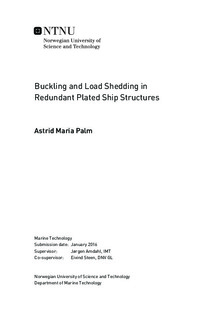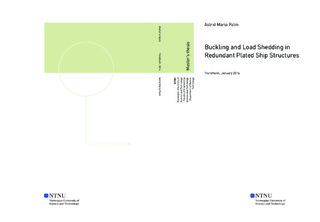| dc.description.abstract | A linear Finite Element(FE) procedure developed by DNV GL as an alternative to standard design procedures for redundant plated panels has been tested and evaluated. The method is based on modifying the so-called macro material input in an anisotropic FE-model, so as to cope with structural non-linearities by essentially using a linear approach. In the studies performed in this thesis, both the initial loss of stiffness at the presence of imperfections and the load-dependent behaviour of compressed plates are addressed. The evaluations are performed in light of a number of parametric studies on the elastic buckling behaviour and imperfection sensitivity of unstiffened plates and larger multi-bayed panels. The Non-liner Finite Element software Abaqus is used as main tool.
As an introductory to the elastic buckling problem, a study of the compressive strength of biaxially loaded unstiffened plates was performed. The results showed that a significant stiffness reduction takes place in the vicinity of the elastic buckling limit, followed by a nearly constant post-buckling stiffness. This implies an extensive load-shedding to adjacent supporting elements that is not captured by standard linear procedures. Subsequent studies including an initial geometry equal to that of the transverse eigenmode documented the effects of initial imperfections on the initial stiffness. The transverse and the coupled stiffness were seen to be highly affected by the imperfection amplitude, the latter even taking on a negative value for major imperfections. The immediate deflection mode after onset of compression proved to have a considerable impact on the initial stiffness. Large imperfection amplitudes imposed an advanced deflection mode in the form of a flattened buckle along the mid-plate, which displayed a lower stiffness than the applied imperfection mode.
Based on a number of parametric studies including variations of the plate aspect ratio, slenderness and imperfection level, the explicit formulations for initial stiffness developed by DNV GL were compared with numerical results. High agreement was found for small imperfections and moderate aspect and slenderness ratios. Considerable deviations were seen for larger imperfections, with the numerical results being on the lower side. The deviating trend was more pronounced for large aspect ratios and slender plates. The knock-down of numerical results was found to be due to the altered deflection mode imposed by large initial distortions. This behaviour is not captured by the analytical formulations, which presumes a constant deflection mode equal to the initial imperfection.
A study on the effects of various imperfection geometries and lateral pressure was performed on a multi-bayed model similar to a typical stiffened panel. The imperfections were defined as weighed combinations of the unfavourable eigenmode and the more realistic "Hungry-Horse"(HH) geometry. The HH-mode was found to be stiffer than the geometries with eigenmode contributions, and even coincided with the linear elastic stiffness for small imperfection amplitudes. The emergence of buckling modes was not considerably affected by neither the initial imperfection nor lateral pressure, considering that the eigenmode grew quite rapidly for most conditions.
The practical application of the macro material model was evaluated for a card-deck configuration. A coarsely meshed linear anisotropic model with modified initial stiffness properties was compared to a non-linear isotropic model with geometrical imperfections. The anisotropic approximation showed high agreement with the non-linear model, given moderate imperfection levels. The membrane stresses in the plating, stresses in supporting frames and so the overall stiffness of the panel were successfully mimicked for strain ranges in the proximity of the elastic buckling limit of individual plates. A study on embedding load-dependent effects in the macro material input was found to give accurate estimates of the plate membrane stresses and the stress redistribution to transverse frames at target load-states. Thickness iterations with the macro material model documented a theoretical potential for steel savings for the considered car-deck. The latter however requires an evaluation of all relevant load-conditions and safety limits to be confirmed as a conservative approach.
The main conclusion include two convenient applications of the macro material model in design. Firstly, the imitation of initial stiffness may enable steel savings, depending on the configuration and operation of the considered panel. Secondly, the load-dependent macro material input may serve as a convenient alternative to non-linear procedures in the prediction of the stress redistribution accompanying elastic buckling. However, such a utilization requires more confident assumptions regarding modelling of initial imperfections and a generalization with respect to model configuration and load-conditions to be truly applicable and conservative as a design procedure. | |

